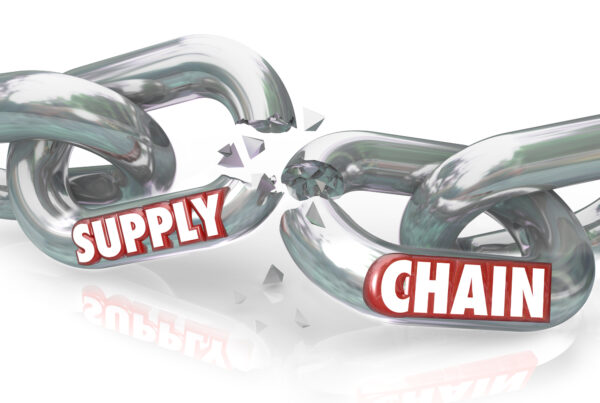Note: This blog will explore digitization, which is the first and most crucial step for a business to become digitalized. A digitalized business is outward facing and customer-centric. Digitization and digitalization are not the same concepts, even though people often conflate the two. Digitization is the beginning of the digitalization journey.
Digitization Is A Business Imperative
Moving from an analog to a digitized supply chain is business critical, and something I often speak about, as it is paramount towards future proofing and scaling your business. Recent research by McKinsey & Company has shown that on average, companies that significantly digitize their supply chains will increase their annual growth of earnings before interest and taxes by 3.2 percent (the most substantial increase from digitizing any business area), and annual revenue growth by 2.3 percent. Digitization offers the opportunity to improve revenue because it removes information silos and friction points giving businesses a comprehensive view of what’s happening in real time, and so enables faster data-driven decision making which results in a more agile business that can quickly meet the needs of consumers, thereby increasing full price sales opportunities.
/analog-to-digitized-banner.png)
Digitization Involves Commitment To Change
Given the importance of digitization, what does the journey to digitized look like? Digitization starts with change management and the building of a foundation for the future. It is a time to begin trusting data, and of working within a connected world using advanced technology to replace traditional manual processes. You’re not only taking your business on a digitization journey but also on a culture, hearts and mind journey too. Digitization is the start to future-proofing your business and remaining meaningful to your customers, by embarking on this journey, you will ultimately drive better fact-based decisions, become more efficient, reduce lead times, and increase revenue margins. Quite simply, you are enabling scalability.
/importance-of-digitization.png)
To date, the adoption of digitization has been slow. One survey indicates that in fact, only three percent of retail companies have successfully digitized across their entire business! The single biggest reason for the slow adoption of digitization cannot, nor should be, attributed to the lack of available technology, as this is readily available. The primary and most significant hurdle is ‘total buy in,’ as this involves a change in mindset, a shift in culture, and the beginning of redefining your business model; a shift that switches focus outwardly, ultimately becoming customer-centric.
However, you need to implement this ‘total buy in,’ from the C-Execs downwards throughout the entire business. Everyone must commit to change, assuring dedication towards timelines, and having a commitment to spend on IT, alongside adopting a ‘customer first,’ and customer-centric mindset.
Guiding You On The Journey
At Gravity Supply Chain Solutions, we are working with both our clients of today and also those of tomorrow, to help support them along their journey. We provide them with the platform and latest technical innovations for the journey from analog to digital. Our solutions are cognitive by design, meaning we can scale up when needed to include AI and ML capability, where supply chain optimizations get made with little or no human intervention (which represents complete digitalization). We are continually investing significant time and money into our people, leveraging the latest technology to ensure our clients remain consumer-centric, relevant, and ahead of the curve.
/gravity-scm-solution.png)
Schedule a product demo with Gravity Supply Chain
How To Become Digitized
To become digitized, you need to make digital all manual processes that exist throughout your business, and your network (the vendors, buying houses, logistics providers, delivery companies, customs brokers, and third party warehouses). Anyone and everyone involved needs to be connected. Gravity Supply Chain also brings in a variety of external data such as information on shipping lines and airline schedules, historical data on carriers ‘on time’ performance along with their uplift and capacity commitments, weather and global news feeds, and just about anything that can have an impact on your supply chain. Layering this data across your processes, enables you to have full visibility over supply chain performance – both historical, and also in real time, along with those of every player, every partner and, every party involved in moving your stock items through the supply chain and in one place.
Often the first and most common obstacles to overcome, are the statements that suggest there to be a lack of IT capability: ‘there are currently too many IT projects on the go,’ or, ‘there aren’t enough resources, or time to send structured data.’, are just a few of the many comments you may have heard? With the new technology, all we need to ask of you is that you send us your data and we will integrate it into our platform ourselves, removing the bottlenecks that often swamp IT teams.
/how-to-be-digitized.png)
The ‘missing data’ has always existed, it’s just been locked away in silos, reducing productivity, creating hurdles and generally preventing smart decision making. These isolated pockets of data often only become available after the event, having been subsequently crunched through spreadsheets typically 30 days later as part of KPI reporting packs. Digitization removes the fragmentation and friction points, breaking open these silos, and identifying risk and opportunity significantly earlier in the process, reporting back to you in real time. You’re not necessarily eliminating headcount; you’re analyzing and optimizing facts and decision-making with certainty while appreciating access to all the data you need in one place. With everyone connected and visible, you benefit from the complete overview of all stock in your supply chain in real time.
To enable us to best support your journey to digitization, we arrange discovery sessions to allow us to identify your full requirements so we can map the processes necessary for digitizing your supply chain. Once this has taken place, all parties involved are suitably aligned, and our engagement is signed off, we will be ready to ‘Go Live’ typically within four to six weeks.
Remaining Relevant
There are no excuses for not committing to a digitized or fully digital business; any risk lies with not engaging or undertaking to digitize soon enough, and certainly not in embarking on this exciting, revolutionary and essential journey. The retention of custom is paramount to the overall success of all businesses, and realizing this loyalty not only tells a positive story, but also drives company revenue, growth, and profits. By not digitizing, or being slow to adopt digitization is a far too significant risk to ignore, and will likely result in lost opportunities, reduction in customer loyalty and ultimately, you potentially run the risk of becoming irrelevant.
It’s time to take the first steps towards digitizing your supply chain; the price of not doing so cannot get understated!



